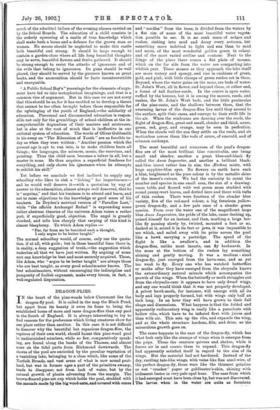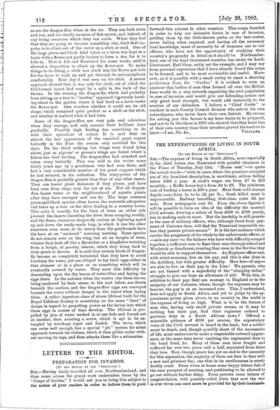DRAGON-FLIES.
IN the heart of the pine-woods below Claremont lies the dragon-fly pooL It is called in the map the Black Pond, but apart from its beauty it owes its fame to being the established home of more and rarer dragon-flies than any pool in the South of England. It is always interesting to try to find reasons for the preference which living creatures show for one place rather than another. In this case it is not difficult to discover why the beautiful but rapacious dragon-flies, the raptores of their own world, should haunt this pine-wood pool in undiminished numbers, while so few, comparatively speak- ing, are found along the banks of the Thames, and almost none on the tidal parts from Richmond downwards. The shores of the pool are encircled by the peculiar vegetation of a vanishing lake, belonging to a class which, like some of the Norfolk Broads, and vast areas of what is now sound peat- land, but was in former ages a part of the primitive swamp, tends to disappear, not from lack of water, but by the natural growth of plants advancing from the margin. The brown-floored pine-set cup which holds the pool, studded with the mounds made by the big wood-ants, and covered with cones and " needles " from the trees, is divided from the waters by a flat rim of some of the most beautiful water vegeta- tion possible to see. It is no rank mass of sedges and rushes, sinking into mud and decay every autumn, but something more indebted to light and sun than to mud and mists, of the most wonderful golden green in colour, and of the most varied outline and contour. Next to the fringe of the pines there comes a flat plain of mosses, which on the far side from the water are compacting into whitish peat. These mosses as they approach the lake itself are more watery and spongy, and rise in cushions of green, gold, and pink, with little clumps of green rushes set in them. Beyond, where the water gains on the moss, are beds of water- St. John's Wort, all in flower, and beyond these, at either end, a forest of tall feather-reeds. In the centre is open water, ruffled by the breezes, but it is among the mosses, reeds, and rushes, the St. John's Wort beds, and the little peninsulas of the pine-roots, and the shallows between them, that the swarming larvae of the dragon-flies live until they ascend to the surface, split their cases, and emerge to their swift life in the air. When the sunbeams are dancing over the reeds, the flight of dragon-flies, great and small, slender and think, azure, green, red, grey, and orange, may be seen in perfection. When the clouds veil the sun they settle on the reeds, and sit motionless across them like rods of azure, of emerald, and of crimson sardonyx.
The most beautiful and numerous of the pool's dragon- flies are of the most brilliant blue conceivable, one being small and slender, another a great blue-and-black fly called the Anax Imperator, and another a brilliant black- and-blue insect rather less in size, the "Eschna mizta, with huge sapphire-blue eyes. No flowers on earth have such a blue, heightened as the pure colour is by the metallic shine of the insect's cuirass. We had the curiosity to count the number and species in one small area, the size of a drawing- room table, and floored with wet green moss studded with round penny-wort leaves, and dotted here and there with tufts of thin rushes. There were fourteen of the slender blue variety, five of the red-sard colour, a big ferocious yellow. green dragon-fly, and a few pale ones of a slender green species. From over the water one of the magnificent large blue Anax I?nperators, the pride of the lake, came dashing up, poised himself for an instant, and then, marking a large bee- like fly passing slowly by, twisted, mounted a foot or so, dashed at it, seized it in its feet or jaws, it was impossible to see which, and sailed away with its prize across the pool like a hawk carrying a partridge. The speed of the flight is like a swallow's, and in addition the dragon-flies, unlike most insects, can fly backwards. In the moss at the bottom of the rushes lay something shining and gently moving. It was a medium - sized dragon-fly, just emerged from the larva-case, and as yet too weak to fly. Every one who has watched butterflies or moths alter they have emerged from the chrysalis knows the extraordinary natural miracle which accompanies the growth of the wings. When the butterfly or moth struggles put from the chrysalis-case it appears to have only dwarf wings, and any one would think that it was not properly developed. A privet hawk-moth, for instance, will emerge with all its body and legs properly formed, but with wings only half an inch long. In an hour they will have grown to their full shape and dimensions. What happens is that the folded and apparently rudimentary wing is really like a parachute with hollow ribs, which have to be inflated first with juices and then with air. This sets up the ribs, and expands the wing, and as the whole structure hardens, fills, and dries, so the miraculous growth goes on.
The same happens in the case of the dragon-fly, which has what look only like the stumps of wings when it emerges from the pupa. These the creature quivers and shakes, while it forces air in and causes them to expand. This dragon-fly had apparently satisfied itself in regard to the size of its wings. But the material had not hardened. Instead of the dry, rustling talc-like wings, with veins like fine steel-wire, of the perfect dragon-fly, these were like the thinnest gebstine or wet "cracker" paper or goldbeater's-skin, shining with iridescent lustre in very pale opal hues. The case from which it had emerged must have been close by, but was not discovered. The larvae when in the water are unite as ferocious
as are the dragon-flies when in the air. They can both swim and run, and are deadly enemies of fish-spawn, and, indeed, of any living creatures which they can catch. When they feel that they are going to become something else, their first im- pulse is to climb out of the water up a stick or reed. One of the large green-mad-black kind taken as a larva was kept in a basin with a flower-pot partly broken to form a den for it to hide in. Here it fed and flourished for some weeks, until it showed a disposition to climb up the flower-pot. To make things to its liking, a stick was stuck into the flower-pot hole for the larva to walk up and get through its metamorphosis comfortably. Next day it was seen on the stick. A nearer approach showed that it was only the shell, out of which the full-formed insect had crept by a split in the back of the thorax. In the evening the dragon-fly, which had probably been sitting on a tree to " harden," appeared vigorously hawk- ing about in the garden where it had lived as a larva under the flower-pot. One wonders whether it could see its old shape, which remained quite perfect as a shell on the stick, and whether it realised what it had been.
Some of the dragon-flies are very pale and colourless when they emerge, and only assume their brilliant hues gradually. Possibly high feeding has something to do with their splendour of colour. It is said that on almost the last appearance of the vanished great copper butterfly in the Fens the swarm only survived for two days. On the third nothing but wings were found lying about, just as pigeons' or grouse's wings are found where a falcon has been feeding. The dragon-flies had attacked and eaten every butterfly. This was told to the writer some thirty years ago by a gentleman who had seen them, and had a very considerable number of the great coppers which he had secured, in his collection. The wing-power of the dragon-flies is probably greater than that of any other insect.
They can travel great distances if they please, and have been seen from ships very far out at sea. Not all dragon- flies haunt water or the neighbourhood of aquatic plants after they have emerged and can fly. The large common green-and-black species often leaves the waterside altogether and takes up a beat on the drive leading to a country house. This suits it exactly, for the lines of trees on either side prevent the insects haunting the drive from escaping readily, and the fierce, voracious dragon-fly cruises at lightning speed up and down the ready-made trap, in which it has the other creatures even more at its mercy than the greyhounds have the hare at an " enclosed " coursing meeting. Some species do not remain ever on the wing, but sit on boughs of trees, whence they dash off like a flycatcher or a kingfisher watching from a bough, at passing insects, which they bring back to their perch to devour. It is said that certain kinds of dragon- fly become so completely terrestrial that they have to avoid touching the water, yet are obliged to lay their eggs either in that element or in a place or on something which will be eventually covered by water. They meet this difficulty by descending upon the dry leaves of water-lilies and laying the eggs them In the autumn when the waters rise these leaves, being anchored by their stems to the root below, are drawn beneath the surface, and the dragon-flies' eggs are conveyed beneath the water without danger to the insect when laying them. A rather ingenious class of steam lifeboat built for the Royal Lifeboat Society is something on the same " lines" of design in regard to propelling power as the larvae into which these eggs in course of time develop. The lifeboat is pro- pelled by jets of water sucked in at one hole and forced out at another, thus avoiding a screw, which is apt to be en- tangled by wreckage ropes and fouled. The larva, which can swim well enough, has a special " jet " system for silent approach towards its victims, which it thus glides under with- out moving its legs, and then attacks them like a submarine.







































 Previous page
Previous page